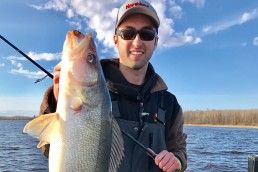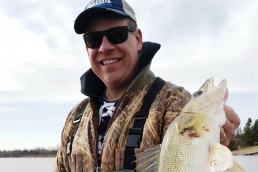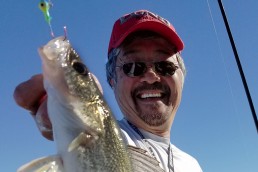River Walleyes or Spring Binge Panfish?
SHARE THIS POST
Spring
Spring means different things to different people. Everything relates to fishing for me, so spring is all about ice-out on lakes and rivers. The only question is do I target river walleyes or spring binge panfish?
The first place with open water in my part of the country is the Rainy River, which flows along the U.S./Canadian Border between Rainy Lake and Lake of the Woods.
The Rainy River usually opens up sometime in mid to late March. The spring walleye season runs from March 1 until April 14, 2020, so the season is usually open as soon as anglers can get their boats in the river.
Some anglers slide smaller boats over the shore ice long before other anglers with full-sized boats can get their boats into the river. When an access gets close to open, somebody usually opens it up the rest of the way with a plow or a front-end loader.
The bag limits for walleyes changed last year for the spring season. Anglers are no longer allowed to keep walleyes of any size during the spring season on the Rainy River. Catch-and-release all walleyes and sauger immediately, with a quick photo allowed if you catch a trophy.
I thought the no-harvest rule would cut down on the number of anglers during the spring walleye season, but there were just as many anglers last spring and maybe even more than in some years past. I would expect something similar this spring, especially after the challenging winter in much of the Ice Belt.
There are usually anglers ice fishing on Lake of the Woods at the same time other anglers are just starting to fish out of their boats on the Rainy River.
Catching walleyes never gets old, at least for me. That’s what gets me out of bed in the morning and keeps me fishing more than 300 days a year.
The Rainy River gives anglers a shot at catching dozens of walleyes, with a few trophy-sized walleyes mixed into the catch. Anglers have a realistic chance of catching walleyes longer than 30 inches, so have a camera ready.
Walleyes
Similar patterns happen in many large rivers across the northern U.S. and Canada. Walleyes like to spawn in current, so they often make spawning migrations up the rivers connected to most large walleye lakes.
The right combination of current, depth and bottom content are needed to give walleyes the conditions they need to spawn. Many of the best walleye lakes are able to sustain their populations through natural reproduction, which is really quite impressive when you think about it.
Walleyes come into the rivers in groups, often running the shallow stretches of the river at night. Walleyes usually rest and feed in the deeper holes along the way to their spawning sites.
Jigs and minnows or jigs and plastics are the baits of choice for most anglers. I like Northland Whistler Jigs in ⅜- or ½-ounce sizes, because they can be paused or held steady in the current and still have the blade turning to attract larger walleyes.
I use heavy enough jigs to stay vertical below the boat. If you use too light a jig, it washes downstream too far and you lose control of your jig.
Are you enjoying this post?
You can be among the first to get the latest info on where to go, what to use and how to use it!
I like bright UV colors that glow or have some gold in the color pattern, which are usually the best colors for walleyes in stained water. I use a 6’ 3” medium-action St. Croix Legend Elite rod for heavier jigs.
Some anglers like to troll crankbaits upcurrent, but there has to be enough room to troll without getting the lines caught while landing fish. There are often too many boats in many areas to make trolling artificials practical.
The same patterns happen in many locations across the Ice Belt, with anglers fishing for walleyes in most major rivers coming out of the Great Lakes or between larger lakes.
Once most rivers are open (ice-free), the lakes will begin to open up. There is a brief opportunity for pre-spawn perch right after the ice goes out in many lakes close to my home in northern Minnesota.
Panfish
Perch lay their eggs on standing weeds or anything else in the water the perch can use to lay their strands of eggs, like putting tinsel on a Christmas tree.
The males move into the spawning areas first and will stay until there are no more remaining females to spawn. Female perch hold in deeper water until the last minute, then move into the spawning areas and back out quickly after they spawn.
Anglers can fish for perch using a simple bobber rig with a small jig. A minnow, piece of nightcrawler or waxworms will all work for bait, along with scented plastics like Northland Impulses. Casting to darker patches between the standing weeds, which usually indicates deeper water.
Don’t cast and work the bait all the way back to the boat because of the weeds. Cast to specific spots and work the bobber a little bit, before reeling in quickly and casting to a new spot.
My MinnKota Talon is perfect for fishing shallow water. I drift through the weeds and set the Talon down when I see fish or a spot that looks fishy to me. I always fish ahead of the boat, so the shadow of the boat doesn’t spook the fish.
The next opportunities for open water are crappies and sunfish that feed in shallow backwaters or shoreline areas that warm up faster. The temperature gauge on my Helix 12 is very important in the spring; it helps me find the warmest water.
Crappies and sunfish are also looking for the warmest water. That’s where the first insect hatches happen, and also where schools of minnows gather to feed. The north and west sides of bays and shorelines warm up faster because of the angle of the sun, so those are the areas I search first for spring crappies.
I like the St. Croix Legend Elite Panfish Series for crappies, sunfish and perch. I like longer rods for casting distance with bobbers ,and keep my Frabill Conservation Series net handy, to avoid having to lift soft-mouthed crappies into the boat.
Become a MidWest Outdoors Insider here!
MWO
SHARE THIS POST
Did you enjoy this post?
You can be among the first to get the latest info on where to go, what to use and how to use it!
Brian 'Bro' Brosdahl
Outdoor communicator Brian “Bro” Brosdahl lives in northern Minnesota. He is a walleye guide in the Cass Lake, Leech Lake and Lake Winnibigoshish areas. He is sponsored by Northland Fishing Tackle, Frabill/Plano, Aqua-Vu, Humminbird/Minn Kota, St. Croix Rods, Ranger Boats, and Evinrude. Guide inquiries: brosguideservice.com. Follow on social media.



